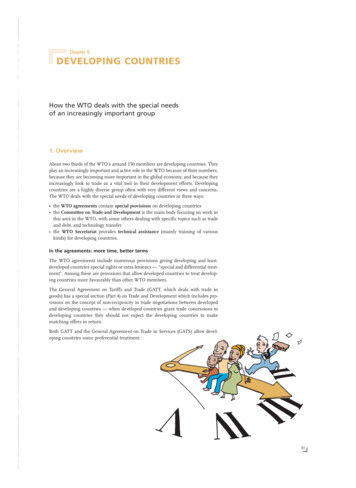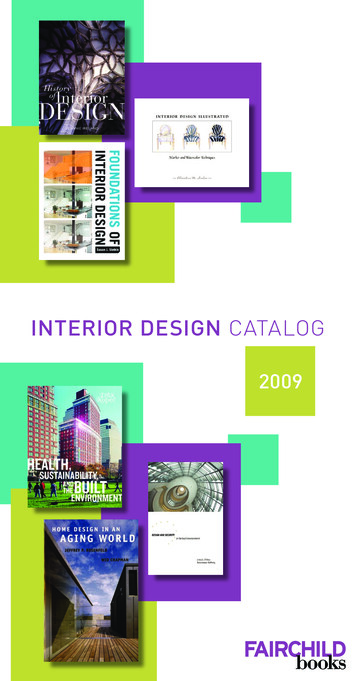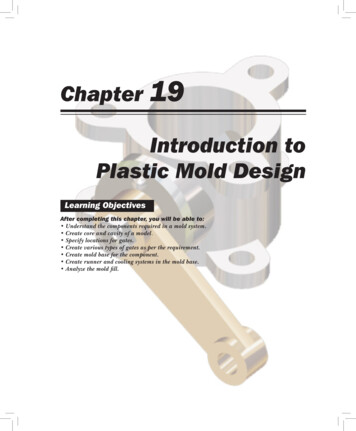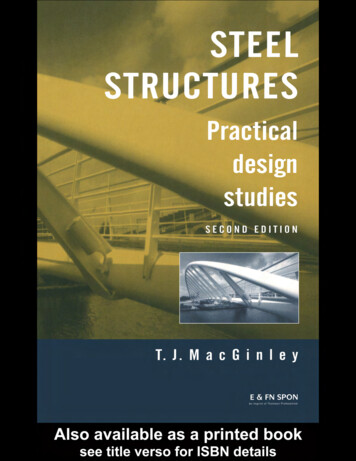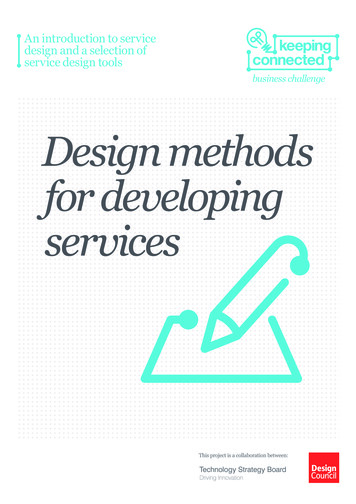
Transcription
An introduction to servicedesign and a selection ofservice design toolsbusiness challengeDesign methodsfor developingservices
Keeping Connected Business ChallengeDesign methods for developing servicesAbout this documentThe double diamond design processTools and methodsAbout thisdocumentThis is a brief introduction to whydesign methods can be usefulwhen developing services.If you’re new to service design:You can use it to familiariseyourself with a typical processthat designers use whendeveloping products and services.It will give you an idea of what toexpect from working with a designer.If you’re a designer:You may be familiar with all ofthis already, but you may find thisdocument useful when explainingcommon service design methodsto others that are new to them.ContentsAbout this document3 About design and whywork with a designer4 Using design to developgreat servicesThe double diamonddesign process6 The doublediamond overview8 What to do at each phaseTools and methods11 Discover phase16 Define phase19 Develop phase22 Deliver phasePage 2
Keeping Connected Business ChallengeDesign methods for developing servicesAbout this documentThe double diamond design processAbout design" Design is what links creativity and innovation.It shapes ideas to become practical and attractivepropositions for users or customers. Design may bedescribed as creativity deployed to a specific end."— The Cox ReviewTools and methodsDesign has many different definitions, but at its heartit is about the process of translating ideas into reality,making abstract thoughts tangible and concrete.Whether it’s for a new service, a piece of graphicsor an innovative product, a number of key attributesunderpin every design-led project. Thesefundamentals should inform the responses to theKeeping Connected Business Challenge, ensuringdesign-led solutions that enhance independentliving and quality of life for older adults.Why work with a designer?User understandingDesigners look to understand the needs and desiresof the people who will use a product or service byspending time with them. This approach ensuressolutions are both fit for purpose and desirable tothe people who will use them. By focusing on humanstories and insights designers build empathy for users,and ensure ideas being developed are relevant.PrototypingDesigners work iteratively to test their ideasand improve them throughout the entiredevelopment process. Making an idea tangiblefrom an early stage through cheap mock-upshelps save resources and can minimise risk.Prototyping can be applied to both products andservices, and allows real world feedback fromusers that ensure better, more relevant outcomes.It can be quick and cheap and allows a solution tobe iterated and improved before it is rolled out.A tool for collaborationThe Keeping Connected Business Challengeinvolves collaboration between multidisciplinaryteams. Designers make things visual and tangible– they draw pictures, they make models; this allowsthe complex or ambiguous to be made simple andstraightforward. Doing this allows ideas to be rapidlycommunicated and understood, which in turn fosterscollaboration between designer, partners and users.Page 3
Keeping Connected Business ChallengeDesign methods for developing servicesAbout this documentThe double diamond design processUsing design to developgreat servicesService design is all about making the serviceswe use usable, easy and desirable.Services are all around us - buses, shops, libraries,dentists, restaurants and the post office help us get towork, get our food, or keep in contact with each other.A service happens over time and is madeup of touchpoints – the people, information,products and spaces that we encounter.For instance a menu, a chair or a waitress are alltouchpoints that make up a restaurant service.Tools and methodsService design is the process of creating thesetouchpoints and defining how they interact with eachother and with the user. To design a great service itis important to have service users in mind: are theystaff, suppliers or customers? Using design toolsand methods can deliver an in-depth understandingof user behaviours, their likes and their needs,which can enable new solutions to be developed.Service design can be used to re-design an existingservice to make it work better for users, or it canbe used to create an entirely new service.Page 4
Keeping Connected Business ChallengeDesign methods for developing servicesAbout this documentThe double diamond design processTools and methodsThe doublediamond designprocessPage 5
Keeping Connected Business ChallengeDesign methods for developing servicesAbout this documentThe double diamond design processTools and methodsThe design processTools and methodsEvery designer has a slightly different approach anddifferent design specialisms also have their own waysof working, but there are some general activities commonto all designers. The Design Council has developed the‘Double Diamond’ model to illustrate this.Outlined in this section are design tools andmethods you might find helpful to use as part of theKeeping Connected Business Challenge. It is nota definitive list, but is included to help familiarisecollaborators with design ways of working.Divided into four distinct phases: Discover, Define,Develop and Deliver, it maps how the design processpasses from points where thinking and possibilitiesare as broad as possible to situations wherethey are deliberately narrowed down and focusedon distinct objectives.These methods are not rigid protocols to be followedunthinkingly, but frameworks that can and shouldbe adapted to the task at hand. Some of the toolswork best at ‘big picture’ thinking while other focuson specific project details. Balancing and linking thetwo is important to develop the best outcome.Most tools and methods can be adapted byaltering the level of detail, sketching quickly ordeveloping in-depth, depending on the outcomesneeded or time and resources available.Overview of the double diamond phases1. Discover2. Define3. Develop4. DeliverPage 6
Keeping Connected Business ChallengeDesign methods for developing servicesAbout this documentThe double diamond design processTools and methodsThe double diamond in more detail1. Discover2. Define3. Develop4. DeliverThe start of a project isa period of discovery,gathering inspiration andinsights, identifying userneeds and developinginitial ideas.The second quarterrepresents the definitionphase, in which designerstry to make sense of all thepossibilities identified in theDiscover phase.The first quarter of thedouble diamond modelcovers the start of theproject. Designers try tolook at the world in a freshway, noticing new thingsand seeking inspiration.They gather insights,developing an opinionabout what they see,deciding what is new andinteresting, and what willinspire new ideas.Specific methods include:market research, userresearch, managing andplanning and designresearch groups.Which matters most?Which should we acton first? The goal here is todevelop a clear creative briefthat frames the fundamentaldesign challenge to theorganisation. Key methodsduring the Define phaseare: project development,project managementand project sign-off.The third quarter marksa period of developmentwhere solutions are created,prototyped, tested anditerated. This process oftrial and error helpsdesigners to improve andrefine their ideas.The final quarter of thedouble diamond model isthe Deliver phase, wherethe resulting productor service is finalisedand launched. The keyactivities and objectivesduring this stage are: finaltesting, approval andlaunch, targets, evaluationand feedback loops.Key activities andobjectives during theDevelop phase are:brainstorming, prototyping,multi-disciplinary working,visual management,development methodsand testing.Page 7
Keeping Connected Business ChallengeDesign methods for developing servicesAbout this documentThe double diamond design processTools and methods1. The Discover phase2. The Define phaseObjectivesObjectives Identify the problem, opportunity or needsto be addressed through design Analyse the outputs of the Discover phase Define the solution space Synthesise the findings into a reducednumber of opportunities Build a rich knowledge resourcewith inspiration and insights. Define a clear brief for sign offby all stakeholders.The beginning of every design project is marked by anexploratory phase where insights and inspiration aregathered. This Discover phase can be triggered in manydifferent ways such as social trends, novel technology,the launch of a competitor service, or in the case of theKeeping Connected Business Challenge, a funding call.The initial Discover phase is about openingout and exploring the challenge to identifyproblems and opportunities. The Define stagechannels these towards actionable tasks.In the Discover phase we begin to identify the problem,opportunity or need to be addressed as well as definesome of the boundaries of the solution space.This exploration uses both qualitative andquantitative research methods and can involveboth directly engaging with end users andanalysis of wider social and economic trends.This research builds a rich bank of knowledge thatwill inform the rest of the design process and actas a guide and inspiration to the design team.Tools & MethodsThe mass of ideas and findings are analysed andstructured into a reduced set of problem statements.These are aligned with the organisational needs andbusiness objectives to identify which to take forward.The Define phase results in a clear definition of thefundamental challenge or problem to be addressedthrough a design-led product or service.Tools & MethodsUser Journey MappingUser PersonasUser DiariesBrainstormingService SafariDesign BriefUser ShadowingPage 8
Keeping Connected Business ChallengeDesign methods for developing servicesAbout this documentThe double diamond design processTools and methods3. The Develop phase4. The Deliver phaseObjectivesObjectives D evelop the initial brief into a productor service for implementation Taking product or service to launch D esign service components in detailand as part of a holistic experience Iteratively test concepts with end users.The Develop phase takes the initial design briefand through an iterative process of developing andtesting, refines the product or service conceptsuntil they are ready for implementation.Using design and creative techniques, thedesign team and partners develop the individualservice components in detail and ensure theselink together to form a holistic experience.In the Develop phase working iteratively and testingwith users throughout the process helps ensure amore robust service and focuses the teams’ efforts.The final product or service will incorporate thisfeedback and be ready for implementation.Tools & MethodsService Blueprinting Ensure customer feedback mechanisms are in place S hare lessons from developmentprocess back into the organisation.In the Deliver phase, the product or serviceis launched and begins to address theneeds identified in the Discover phase.The final concept is taken through final testing, finalisedand signed off. It is important to ensure systems are inplace to capture user feedback, especially for services.The Deliver phase is also the point to feed back lessonsfrom the process to colleagues and partners, sharingnew knowledge, insight tools, or ways of working.Tools & MethodsScenariosExperience PrototypingBusiness Model CanvasPage 9
Keeping Connected Business ChallengeDesign methods for developing servicesAbout this documentThe double diamond design processTools and methodsTools andmethods3. Develop2. Define1. DiscoverThe start of a project is aperiod of discovery, gatheringinspiration and insights,identifying user needs anddeveloping initial erShadowingd,Design-led solutions are developeprototyped, tested and iterated.sThis process of trial and error helpdesigners to improve and refinetheir ideas.In the Define phassynthesised an e ideas ared aligned withbusiness objectives, creatinga clear brief that frames thedesign ePrototypingBrainstormingBusiness ModelCanvasDesignBrief4. DeliverIn the Deliver phase, the product or service istaken through final testing,finalised and launched.ScenariosPage 10
Keeping Connected Business ChallengeDesign methods for developing servicesAbout this documentThe double diamond design processTools and methodsTools and methodsUser JourneyMappingWhat is it?How can I do this myself?A User Journey Map is a visual representationof a user’s journey through a service, showingall the different interactions they have. Thisallows us to see what parts of the servicework for the user (magic moments) and whatparts might need improving (pain points).A User Journey Map takes the user’s point of viewand explains their actual experience of the service.User Journey Mapping draws on the outputs ofdesign research methods such as observationor service safaris. These ground the journeymap in real user experiences rather than anabstract notion of how the service works.Map a user’s progress through the service,beginning with when they first become aware ofthe service through to when they leave. In doingthis the different activities of the user journey aredefined, with related tasks grouped together inkey stages, such as ‘sign-up’ or ‘payment’.Aims Identify the key elements of a service U nderstand the links between all the differentelements over time I dentify problem areas in a service or areaswhere new things can be added Create empathy with different types of users.Identify the individual touchpoints with each stage – thepeople, information, products and spaces encountered– are identified. Links or gaps between touchpointswill reveal themselves as the map is developed.To get a holistic view of a user’s experience it canbe useful to work in cross-functional teams. Someservices might have different types of users, withdifferent experiences, and require multiple journeys.What are the outputs?A User Journey Map is a visual map or diagram,identifying the key stages, touchpoints and othercomponents that make up a user’s service experience.The journey map might contain photographs,illustrations and quotes to bring it to life. It mayalso have an additional layer of explanation thatidentifies problem areas or opportunities.See page 12 for an example of a User Journey Map.Page 11
Keeping Connected Business ChallengeDesign methods for developing servicesAbout this documentThe double diamond design processTools and methodsTools and methodsUser JourneyMappingJourney chart example for a mobile phone serviceTouchpointsTelevisionAwareJoinBobHaving seen thephone he wanted instore, he goes onlineto get a better deal.Finds the websitehard to navigate.ShopSHOPPostLeaveBobSees advert for newphone on TV – isinterested by the highquality camera.OnlinePhoneUseHelenSees an advertwhilst passing a shopwindow and likesthe sound of the payas you go deal.HelenCancels hercontract onlineafter two years.Finds it surpisinglyeasy to do.BobOn his lunch breakwalks into Walk&Talkmobile phone store.Is greeted by a shopassistant who answersall his questions.HelenPhones the mobilephone companyand orders thephone she saw.Spends an hourwaiting in a queue.HelenReceives her newphone in the post2 days later. Has totake a half day offwork to make sureshe doesn’t missthe delivery.BobAfter a year hereceives a newphone in the postas part of hiscontract. Finds itvery easy to switchhis contacts overto new phone.Page 12
Keeping Connected Business ChallengeDesign methods for developing servicesAbout this documentThe double diamond design processTools and methodsTools and methodsUser DiaryWhat is it?How can I do this myself?User Diaries are a method for gathering in-depthqualitative information from users by giving them away of recording away from researchers. It allowspeople to tell about their own lives in their own time, andexplain what they do over a number of days or weeks.User Diaries can be realised in many differentformats but usually consist of some personalbackground information and a ‘diary’ styleformat for capturing information over time.The key to good User Diaries, as with all qualitativeresearch, is identifying the correct people to take part.In general, a relatively small group is sufficient; theaim is to get rich information and insights to drive thedesign process, rather than quantitative answers.User Diaries are created based on the context of theproject and needs of the design team. The diary periodcan vary from a few hours to a number of monthsand again is dependent on the individual project.This basic information can be supplemented withadditional questions or tasks. Sometimes camerasor other documentation equipment is providedto gather visual feedback for researchers.In general User Diaries consist of three main sections.Aims Gather information about real user needs G et understanding and empathy about otherpeople’s experiences G et a sense of a user’s life over a longerperiod of time. B ackground information that covers name,age, occupation, location, family, hobbies& interests, likes & dislikes. This helps togive some understanding of the person A Diary section for users to complete over aperiod of time – just like a diary. This shouldhave a number of prompts or questionsto provide some structure. It might usephotography or video to document A dditional questions and tasks thatprovide stimulus to users to gain moreinsight from them on particular topics.What are the outputs?Completed User Diaries supply rich qualitativeinformation on a set of users over time.They might include video and photographsas well as written descriptions.User Diaries help identify important user needs andinsights and provide inspiration to design teams.Page 13
Keeping Connected Business ChallengeDesign methods for developing servicesAbout this documentThe double diamond design processTools and methodsTools and methodsService SafariWhat is it?How can I do this myself?A Service Safari is a research method forunderstanding services. Researchers go ‘onlocation’ and experience a service first hand tofind out what service experiences are like.Service Safaris are a useful exercise at the beginningof a design process. They help everyone gain arich understanding of services and are relativelyeasy to structure. The key to a good service safariis to identify relevant, engaging services that revealinsights and provide inspiration to the design team.Each participant should record their experiencein writing, or by using video and photography.Engaging with a service, observing staff, lookingat users and documenting the environmentand materials, helps participants identify howservices deliver value to customers.A Service Safari might be focused on a particularservice (like going to Tesco), or type of services(like going to a supermarket). Alternatively itmight look at a wider range of services to getan idea about what makes a positive serviceexperience (like services where I can buy food).Aims G ather information about a service in thereal world I dentify what makes for a good serviceexperience across many differentservice types.A Service Safari can be somewhat haphazardso in a large group assigning roles is an option.Through sharing their experiences the team canbuild a collective understanding and begin todefine what makes a great service experience.What are the outputs?The output of a Service Safari is some writtenor visual record of the event and mightinclude photographs, drawings or video.More important is the experience itself, Service Safarishelp team members tune into service touchpoints andexperiences, and interrogate these in new ways.Page 14
Keeping Connected Business ChallengeDesign methods for developing servicesAbout this documentThe double diamond design processTools and methodsTools and methodsUserShadowingWhat is it?How can I do this myself?Shadowing is a research method for understandinghow people interact with the world around them(including services). It involves observing a userdirectly to identify and understand their needs.Time should be spent identifying the correct peopleto shadow. In general, a relatively small groupis sufficient as the aim is to get rich informationand insights to drive the design process.Shadowing involves spending time with the personover a number of hours or days and observing whatthey are doing and why. This might take place inone session or over a number of different sessions,and is done as unobtrusively as possible.Researchers follow a particular person as they goabout their lives or use a service and documentwhat happens in an unobtrusive way.Aims Gather information about real user needs G et understanding and empathy aboutother people’s experiencesGetting immersed in a person’s life helps identifythe barriers and opportunities they encounter, eventhose the user is not explicitly aware of. It allowsthe researcher to develop real understandingof service interactions, and see the differencesbetween what people say and what they do. U nderstand the different parts of a servicesuch as staging, interactions and touchpointsWhat are the outputs? I dentifying barriers and opportunities forservice innovation.The output is in general written documentationwith supporting visual materials such asphotographs, drawings or video capturedduring the shadowing session.These materials, observations and insights provideinput into the Define phase of the design process.Page 15
Keeping Connected Business ChallengeDesign methods for developing servicesAbout this documentThe double diamond design processTools and methodsTools and methodsUser PersonasWhat is it?How can I do this myself?A User Persona is a character that embodiesuser research in an easily identifiable andunderstandable form. It brings together lots ofinformation about similar people to create a singlecharacter that represents the group. Personas arenormally created as a set, showing different typesof users with different needs. User personas canbe communicated in a wide variety of formats butare normally a combination of images and text.A Persona can cover information such as name,age, occupation, where they live, family, hobbies &interests, likes & dislikes, and most importantly needs.User personas can be created with varying levelsof detail. Quickly sketched in a workshop theyprovide useful input into brainstorming and ideationtasks. More detailed Personas are valuable insynthesising and sharing large bodies of userresearch, as well as testing early stage concepts.While Personas can be created without drawingon user research, their value and usefulnessgreatly increases if built on qualitative information.Segmentation of user data helps structureresearch and indentify key Personas.Aims P ackage user research into an easy tounderstand format M aintain focus on the needs of users duringthe Develop stage T est and evaluate ideas and serviceconcepts against these needs.Personas should be made as rounded aspossible; they are archetypes, not stereotypes.They can be further enhanced through visualmaterials or supported with quotes, that reflectthe qualitative research and feel authentic.What are the outputs?User personas can vary in terms of output andfinish. At their most basic they might consist of asketch with key user information, supplementedwith photographs or illustrations. Detailed personasmight be communicated through in-depth reports,visual materials, diaries or through video.Personas are a useful guide in the Developphase of the design process and helpmaintain focus and deliver value to users.Page 16
Keeping Connected Business ChallengeDesign methods for developing servicesAbout this documentThe double diamond design processTools and methodsTools and methodsBrainstormingWhat is it?How can I do this myself?Brainstorming and other ideation techniques are usedto generate alternative solutions and opportunitiesquickly. They identify the most interesting or importantideas to take forward as part of the design process.There are a large number of brainstorming andideation techniques available. In general, a facilitatorstructures the group session and ensures a richdiscussion. In successful brainstorms it is importantnot to have too many people or carry on too long(no more than 12 people for longer than an hour).Brainstorming is particularly useful to break out ofestablished patterns of thinking, and develop newways of looking at things. It also helps overcomemany of the issues that can make group problemsolving a difficult or unsatisfactory process.Aims Generate a large number of potential ideas Identify key ideas to develop further C reate a shared understanding of potentialopportunities around a topic or theme.Involving a range of different people withdiverse skills and perspectives is important.This increases the richness of ideas exploredand builds buy-in from team members.It can be useful to have several sessions, lookingat different sub-themes or topics, or have multiplegroups work on the same topic. Capturing ideasin a visible way allows everyone to see progressand ensure the conversation stays focused.While brainstorming and ideation techniques are alldifferent, these are some good rules to remember. Defer judgement Build on the ideas of others Focus on the topic One conversation at a time Encourage wild ideas.What are the outputs?Brainstorming and other ideation techniqueswill result in a large volume of ideas around aparticular topic. These are then reduced down toa number of key ideas to be developed further.Page 17
Keeping Connected Business ChallengeDesign methods for developing servicesAbout this documentThe double diamond design processTools and methodsTools and methodsDesign BriefWhat is it?How can I do this myself?A Design Brief is a clear definition of the fundamentalchallenge or problem to be addressed through adesign-led product or service.A design brief is usually developed by the projectmanager or a design management professional.It synthesises current project knowledge from theDiscover and Define phases and outlines next steps.It is a structured statement that outlines goals,constraints, budgets and timelines. It communicatesproject outcomes, identifies potential risks andhighlights how these will be mitigated.Aims D efine the problem or challenge tobe addressed P rovide a reference point for designingin the Develop phase Provide a plan for the Develop phase.A good Design Brief should be written in easilyunderstood language, provide clear direction, but avoidbeing overly rigid in specifying detailed design work.A Design Brief allows for formal sign off by projectsponsors and sets the boundaries of the rest of theservice development process.What are the outputs?A Design Brief is usually a formal written document,which may be supplemented by user researchdata and other background materials.The Design Brief forms a core referencepoint for all stakeholders in the Develop andDeliver phases of the design process.Page 18
Keeping Connected Business ChallengeDesign methods for developing servicesAbout this documentThe double diamond design processTools and methodsTools and methodsServiceBlueprintWhat is it?How can I do this myself?A Service Blueprint is a detailed visual representation ofthe total service over time - showing the user’s journey,all the different touchpoints and channels, as well as thebehind the scenes parts of a service that make it work.A Service Blueprint pulls concepts and touchpointsin development together into a unified structure andprovides a holistic view of the all service elements.A Service Blueprint often looks similar to a UserJourney Map (see page 12). The difference is thatit maps the future service, not the existing.A Service Blueprint helps everyone involved indelivering the service understand their role and ensurethe user has a coherent experience.Aims D esign and problem solve the completeservice experience P rovide guidance when identifying areasto prototype C ommunicate the service to the peopledelivering it, as well as to usersduring testing.Initially map a user’s progress through different servicestages, ranging from awareness, to use, through toleaving the service. In doing this identify touchpointencountered. These touchpoints each can be segmentedinto different channels such as face-to-face or web.The customer oriented elements of a service are knownas the ‘front stage’. Identify and map touchpoints andprocesses that need to happen behind the scenes forthe ‘front stage’ part to work. These might include backoffice staff, logistics systems, or IT infrastructure. This isknown as the ‘back stage’ part of the service. A ServiceBlueprint allows you to see the interaction between thefront and back stages, ensuring links and dependenciesbetween different service elements are coherent.Some services might have a range of different offeringsand require multiple blueprints. In developing a ServiceBlueprint it can be useful to work in teams, and carry outan initial pass before developing in detail.What are the outputs?A Service Blueprint is a visual map or diagramidentifying the key stages, touchpoints and othercomponents that make up a service.This combination of text and graphics may besupported with photos or illustrations, showingparticular touchpoints in more detail or offeringadditional explanation. Depending on complexity,a service blueprint may contain a key to makeit understandable.Page 19
Keeping Connected Business ChallengeDesign methods for developing servicesAbout this documentThe double diamond design processTools and methodsTools and methodsExperiencePrototypingWhat is it?How can I do this myself?Experience Prototyping is a way of te
Prototyping can be applied to both products and services, and allows real world feedback from users that ensure better, more relevant outcomes. It can be quick and cheap and allows a solution to be iterated and improved before it is rolled out. A tool for





